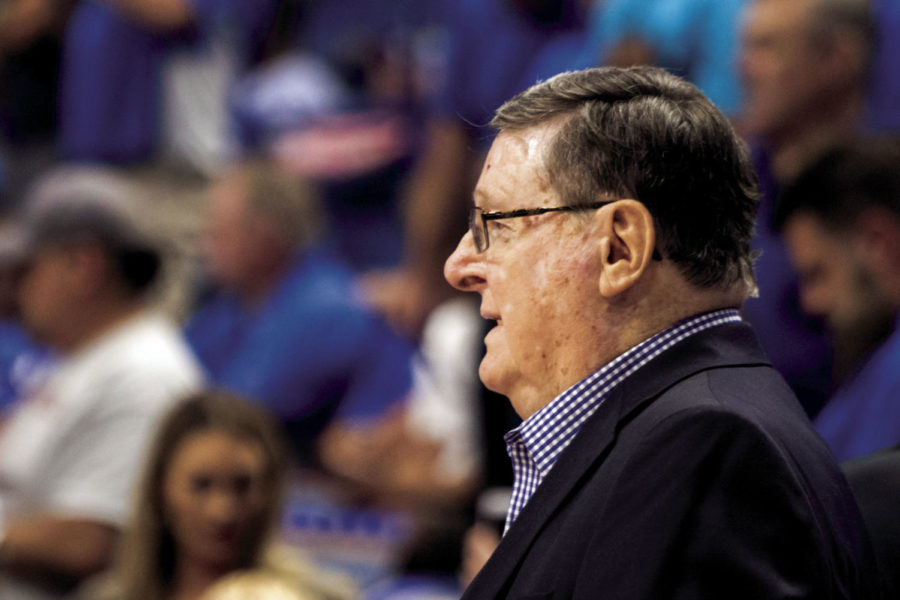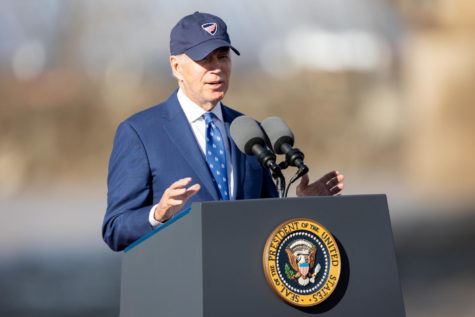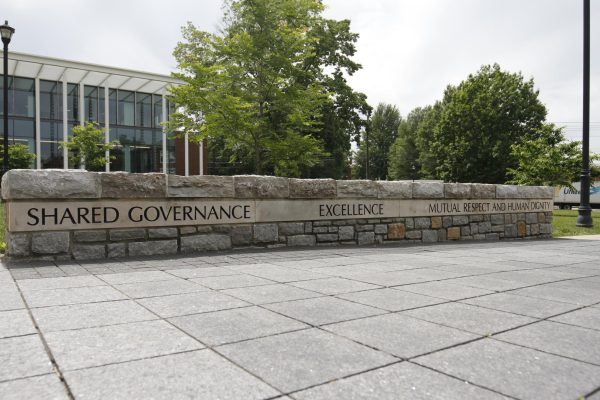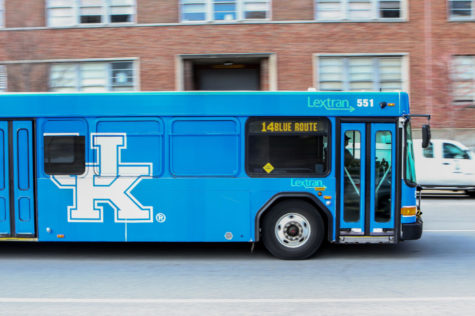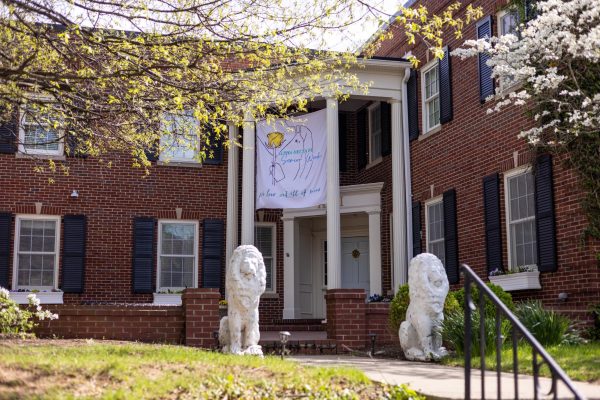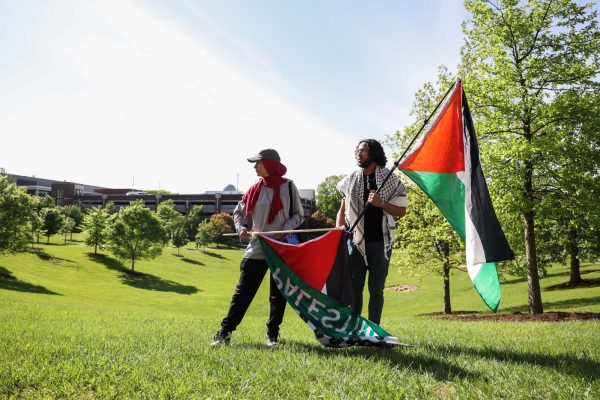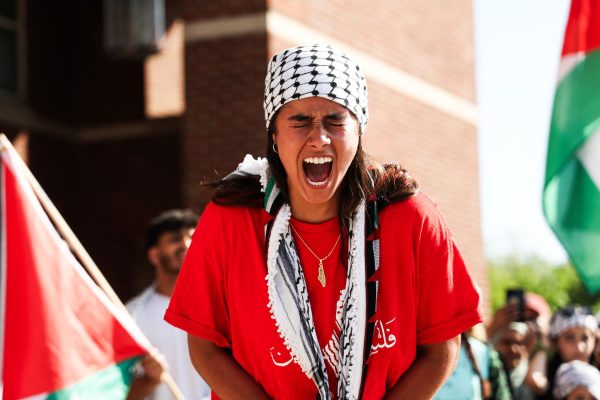Spelling tradition: The history of the ‘Y’
January 10, 2018
For nearly the entire time that Rupp Arena has been home to UK basketball, UK cheerleaders have been spelling out the first seven letters of Kentucky on its floor.
The next part of the tradition: Someone “important” and “popular” comes out on the floor to make a “Y” with their arms, according to T. Lynn Williamson.
Williamson, who is the UK Cheer adviser as well as deputy general counsel for UK, founded the Y tradition shortly after he became cheer adviser.
Sometime between 1979 and 1981, Williamson said he was traveling to SEC away games with the team and looking for inspiration in what the other cheer teams were doing.
He said he thinks that Alabama is where he first saw cheerleaders spelling out the school’s name on the ground. When the Wildcat cheerleaders came back to practice, they decided to try it out for themselves.
“We said, well, if they can do it, we can do it,” Williamson said.
But at first, they actually couldn’t: Kentucky took a lot longer to spell out than Bama, and timeouts were only 60 seconds then. Now, Williamson said, television has lengthened timeouts, but at the time, the cheer team only got to about T of Kentucky in practice before their 60 seconds were up.
Williamson said one of the male cheerleaders came up with a solution: Only use eight or nine people for the K, then decrease the amount of cheerleaders until only two make the final K.
“So we practiced it and we could actually do that in the 60 seconds,” Williamson said.
That part of the tradition remains the same nearly 40 years later.
Cheerleader Whitney Agee, who is a fifth-year integrated strategic communications senior, said that the older men and women on the team are the ones who do the spell-out on the ground.
“Everything is based off seniority in the program,” Agee said.
The Y spell-out has evolved, however. At first, the Y was spelled out on the ground just like the other letters. After doing this at several games, Williamson said the cheer team was looking for something a little different.
“One practice, the mascot was there, so the Wildcat goes, ‘Let me run out and do the Y,’” Williamson said. “Everyone goes, ‘Oh, that’s a great idea.’”
After several games of the Wildcat as the Y, the team again chose something different: Members of the band started spelling the Y. Williamson said that the first time, a male and female band member came out and made the Y together.
But the tradition was still becoming set, and after two or three years, Williamson said someone had the idea to get “someone really special other than just us.” They then had to decide who was best for the job.
“The first criteria was that it has to be somebody that— I won’t say everybody, not all 24,000 people — but the vast majority are going to know,” Williamson said. “And our objective at the end of this was to get people excited, to get people enthused about it, standing up on their feet, to be cheering, for when the team comes back at the end of the timeout.”
That meant the person had to be not only well-known but popular, someone “that everybody loves,” Williamson said. Politicians are never the Y for this reason— the only one that ever was got booed.
“Probably one of the first people we used was Cawood Ledford. We talked Cawood into doing it,” he said. “So he put his headset down and came out and did it on the floor, and you know, everybody recognizes Cawood Ledford and everybody loves Cawood Ledford.”
Actress Ashley Judd, who is still well-known for attending UK basketball games, was the Y shortly after her career began. Her mother and sister were also the Y together once, which was one of Williamson’s favorites because they laid down on the floor like the cheerleaders did to spell out the Y instead of standing.
Williamson said that the head football coach is the most common Y, though of course that hasn’t been the same person for all 30 years.
Former head coach Joe B. Hall is probably the individual who has done it the most, Williamson said.
“We can ask Joe and we know he’ll come out and do it,” Williamson said.
Hall said that he could only make a “wild guess” as to how many times he’s been the Y; Williamson said it’s maybe four or five times.
Hall, who was UK’s head coach from 1972 to 1985, said it is an honor to be asked to be the Y.
“All of us who have done the Y have probably been connected with the university athletics in some way, and it’s always exciting to step out on the floor and represent the university by putting the Y on the end of the cheer,” Hall said. “To have the excitement of the fans respond to that cheer is the most exciting adventure for anyone, and to have that opportunity is an honor and, extremely, a pleasure.”
Hall said he attends nearly every home basketball and football game.
“I love sports in general, and I love Kentucky sports particularly,” Hall said.
Agee, whose mother was also a UK cheerleader, said the Y is a way to show that it’s more than just a basketball game.
“Once you’re here, you’re here,” she said. “It’s your family.”
Cheerleader Kelsey LaCroix, a nursing senior, said that while she does not always recognize the people making the Y, she always feels the excitement, just like the crowd.
“There are just so many people that come out of Kentucky that are just so known around the world and in Kentucky, so I think that’s amazing,” she said.
Both LaCroix and Agee mentioned actor Josh Hutcherson as a favorite Y, but Agee also said getting to walk former player Tayshaun Prince out was a “really cool” experience.
“I was like, ‘Oh my gosh, this is Tayshaun Prince. Oh my gosh, I’m getting to do this?’” she said.
The tradition only takes place at four or five games each season, to keep it special, Williamson said.
“It’s just always fun to see all of them because they love doing it and the crowd loves the people,” he said.









































































































































